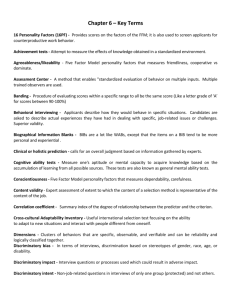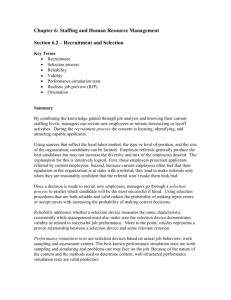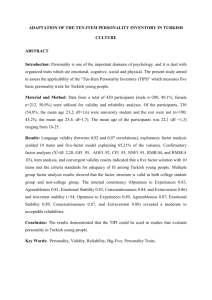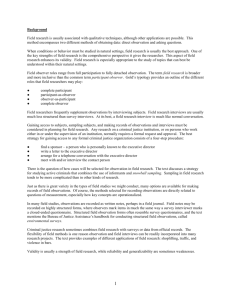Contemporary Issues in Selecting Doctors: the research evidence
advertisement
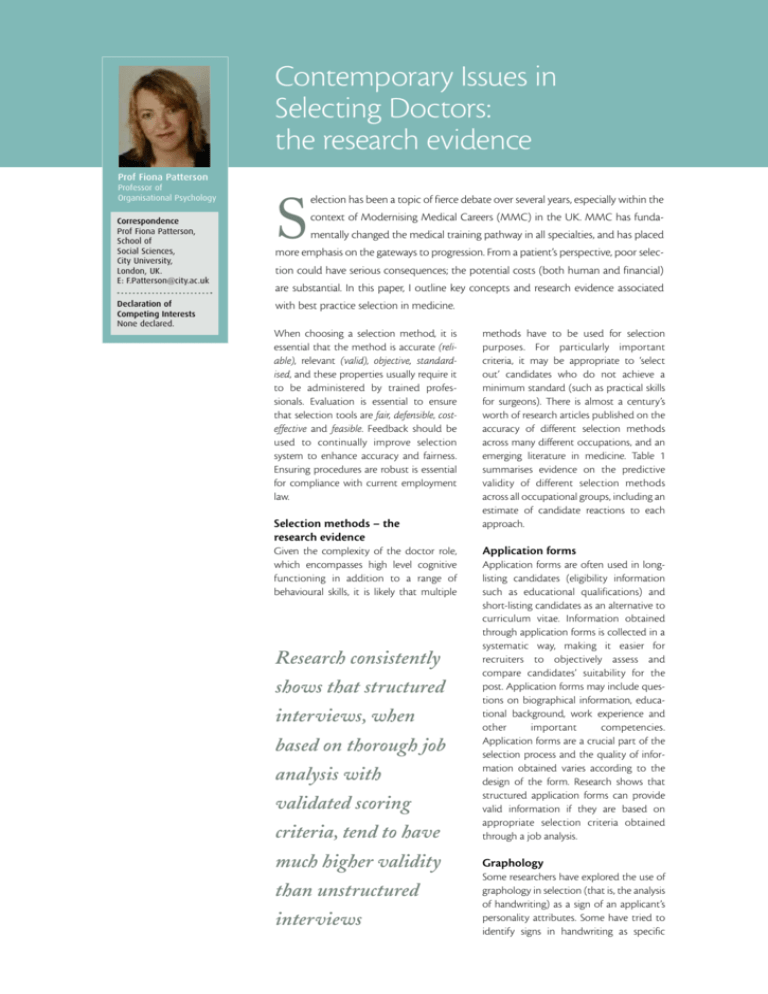
Contemporary Issues in Selecting Doctors: the research evidence Prof Fiona Patterson Professor of Organisational Psychology Correspondence Prof Fiona Patterson, School of Social Sciences, City University, London, UK. E: F.Patterson@city.ac.uk Declaration of Competing Interests None declared. S election has been a topic of fierce debate over several years, especially within the context of Modernising Medical Careers (MMC) in the UK. MMC has fundamentally changed the medical training pathway in all specialties, and has placed more emphasis on the gateways to progression. From a patient’s perspective, poor selection could have serious consequences; the potential costs (both human and financial) are substantial. In this paper, I outline key concepts and research evidence associated with best practice selection in medicine. When choosing a selection method, it is essential that the method is accurate (reliable), relevant (valid), objective, standardised, and these properties usually require it to be administered by trained professionals. Evaluation is essential to ensure that selection tools are fair, defensible, costeffective and feasible. Feedback should be used to continually improve selection system to enhance accuracy and fairness. Ensuring procedures are robust is essential for compliance with current employment law. Selection methods – the research evidence Given the complexity of the doctor role, which encompasses high level cognitive functioning in addition to a range of behavioural skills, it is likely that multiple methods have to be used for selection purposes. For particularly important criteria, it may be appropriate to ‘select out’ candidates who do not achieve a minimum standard (such as practical skills for surgeons). There is almost a century’s worth of research articles published on the accuracy of different selection methods across many different occupations, and an emerging literature in medicine. Table 1 summarises evidence on the predictive validity of different selection methods across all occupational groups, including an estimate of candidate reactions to each approach. Application forms criteria, tend to have Application forms are often used in longlisting candidates (eligibility information such as educational qualifications) and short-listing candidates as an alternative to curriculum vitae. Information obtained through application forms is collected in a systematic way, making it easier for recruiters to objectively assess and compare candidates’ suitability for the post. Application forms may include questions on biographical information, educational background, work experience and other important competencies. Application forms are a crucial part of the selection process and the quality of information obtained varies according to the design of the form. Research shows that structured application forms can provide valid information if they are based on appropriate selection criteria obtained through a job analysis. much higher validity Graphology Research consistently shows that structured interviews, when based on thorough job analysis with validated scoring than unstructured interviews Some researchers have explored the use of graphology in selection (that is, the analysis of handwriting) as a sign of an applicant’s personality attributes. Some have tried to identify signs in handwriting as specific feature Table 1. The relative accuracy of different selection techniques Selection method Evidence for criterion-related validity Applicant reactions Extent of use High Structured interviews High Moderate to positive Cognitive ability High Negative to moderate Moderate Situational Judgement Tests High Moderate Moderate Personality tests Moderate Negative to moderate Moderate Work sample tests High Positive Low Selection centres High Positive Moderate Handwriting Low Negative to moderate Low References Low Positive High indicators of personality. Some recruiters ask applicants to complete the application form by hand as a broad indication of written communication skills. Unfortunately, research has consistently shown that graphology has no predictive validity in selection. References Employers value references as they contain information on attendance records and health records. However, when references are ‘scored’, ratings often tend to be poor at differentiating fairly between candidates. References are useful if information requires verification. Because references often contain subjective information, they are open to error and bias. Despite this, references are widely used in selection, and are likely to continue to be used as additional information in the selection process. The reliability of references can be improved if they are in a structured format. However, given changes in data legislation which remove confidentiality, some suggest that referees sometimes feel uncomfortable in providing ‘honest’ reports. Interviews Interviews are ever-present to the selection process. Interviews can be used at different stages of the process, as the sole selection method or in conjunction with others. Interviews vary in terms of their purpose; duration; medium (for example via telephone); number of interviewers (for example panel); and degree of structure (for example whether questions and scoring criteria are consistent across candidates and interviewers). Research consistently shows that structured interviews, when based on thorough job analysis with validated scoring criteria, tend to have much higher validity than unstructured interviews. Meta-analytic studies have found that structured interviews are valid predictors of job performance. Academic records For entry into medical school, academic criteria and school-end examinations are obviously weighted heavily in the decisionmaking process. One problem with using school-end grades for selection is discriminating among students who obtain similarly high grades and some have argued that such criteria may also reflect social class. Some research has shown that academic criteria correlate with drop-out rates, career progression and fellowship exams. Whilst pre-admission grades are undoubtedly related to academic performance at medical school, their relationship with long-term job performance measures is less obvious, partly because of the practical problems in conducting longitudinal validation studies. General mental ability and aptitude tests Research shows that tests of general mental ability (GMA) and cognitive ability tests are robust predictors of job / training performance across a wide range of occupations. However, as trainee doctors are already highly selected for academic ability the usefulness of such methods is limited and several studies have raised concerns over culture-fairness with marked racial differences in performance. Aptitude tests can measure performance across a range of mental abilities, including more specialised abilities (for example spatial reasoning) to predict job performance. Aptitude tests are increasingly popular in medical school admissions but are rarely used at postgraduate level, as some argue there is a danger of obtaining redundant information. Personality inventories For many occupations, personality testing for selection has increased in recent years. However, the use of personality measures to assess job applicants remains controversial. Critics argue the validity of personality measures for job performance is often low and badly understood. Often there is limited expertise available to choose appropriate tests and some have argued that faking responses could compromise their predictive validity. Best practice is to use personality measures to inform focused questioning at interviews, so that they are not used in isolation to make selection decisions. Situational Judgement Tests Situational Judgement Tests (SJTs) are a well-established measurement method designed to assess a candidate’s judgement regarding a situation encountered in the work place. Candidates are presented with hypothetical scenarios and asked to identify an appropriate response from a list of alternatives. SJTs can be designed to measure a variety of constructs (both cognitive and non-cognitive). SJTs have high face and content validity, and have demonstrated significant incremental validity above tests of cognitive ability. An SJT has recently been introduced for selection into general practice in the UK and has been shown to have good validity. Selection centres Selection centres involve a combination of selection techniques (for example written exercises, group exercises, various work simulations) using a multi-trait, multimethod approach. Selection centres are different to objective structured clinical examinations (OSCEs) as multiple criteria are assessed in one exercise; the candidate experiences multiple selection instruments or situations to demonstrate each key skill, and so is observed by several selectors. Thus a fairer (multiple opportunities to perform) and more reliable judgement can be made. Research shows that a carefully designed selection centre can be highly effective at predicting job performance across a wide range of occupations, feature showing incremental validity over cognitive ability tests. Currently, in all sectors over half of recruiters, and over 95% of large organisations employing more than 10,000 individuals, use selection centres in recruitment. However, it is only recently that this approach has been used in medicine. Summary Research over several decades has provided a much clearer picture of the validity of different selection procedures. No selection system is infallible, but a robust framework for minimising the risks can be provided. The quality of a selection system is heavily dependent upon its design. Poor initial research will inevitably compromise the process. Looking forward, selection systems evolve over time as job roles change and develop, especially in surgery. This evolution will be driven by the emerging research literature and the views of many stakeholders and importantly, the candidates. Box 1. How useful is personality testing in selecting doctors? Think about the five different specialties listed below: ENT surgeon ● General surgeon ● Paediatrician ● Psychiatrist ● Histopathologist For each role, suggest which personality factors might be important in performing the job. Are ENT surgeons born or made? You may also like to think of how people with very different personalities could do a job equally well – but in very different ways. This highlights how personality testing for selection can be problematic. ● Box 2. A Situational Judgement test item You are reviewing a routine drug chart for a patient with rheumatoid arthritis during an overnight shift. You notice that your consultant has inappropriately prescribed methotrexate 7.5mg daily instead of weekly. Rank in order the following actions in response to this situation (1= Most appropriate; 5= Least appropriate). A. Ask the nurses if the consultant has made any other drug errors recently. B. Correct the prescription to 7.5mg weekly. C. Leave the prescription unchanged until the consultant ward round the following morning. D. Phone the consultant at home to ask about changing the prescription. E. Inform the patient of the error. Further reading 1. Patterson F, Ferguson E. Selection into medical education and training. Understanding Medical Education Series. ASME Publications; 2007. 2. Patterson F, Ferguson E, Lane PW, Farrell K, Martlew J, Wells AA. Competency model for general practice: implications for selection, training and development. Br J Gen Pract 2000;50:188-93. 3. Patterson F, Ferguson E, Thomas S. Using job analysis to identify core and specific competencies: implications for selection and recruitment. Med Educ 2008;42:1195-204. 4. Schmidtt N, Chan D. Personnel selection: A theoretical approach. Sage: London, UK; 1998. 5. British Medical Association Board of Medical Education. Selection for specialty training. Report, Nov 2006. 6. Ferguson E, James D, O’Hehir F, Sanders A. A pilot study of the roles of personality, references and personal statements in relation to performance over the 5 years of a medical degree. BMJ 2003;326:429-31. 7. Schmidt FL, Hunter JE. The validity and utility of selection methods in personnel psychology: Practical and theoretical implications of 85 years of research findings. Psychological Bulletin 1998;124:262-74. 8. McManus IC, Powis DA, Wakeford R, Ferguson E, James D, Richards P. Intellectual aptitude tests and A levels for selecting UK school leaver entrants for medical school. BMJ 2005;331:555-9. 9. Patterson F, Baron H, Carr V, Plint S, Lane P. Evaluation of three short-listing methodologies for selection into post-graduate training: the case of General Practice in the UK. Med Educ 2008;42:1195-1204. 10. Patterson F, Ferguson E, Norfolk T, Lane P. A new selection system to recruit general practice registrars: preliminary findings from a validation study. BMJ 2005;330:711-4. 11. Patterson F, Rowley D. The right choice; a pilot scheme to select surgeons of the future. Surgeons News. October 2007. Box 3. A pilot selection centre for surgery In 2007, in addition to interviews, Patterson and Rowley (2007) piloted a selection centre comprising the following set of interactive, written and practical exercises. Each exercise was designed to present ‘a day in the life of’ a trainee surgeon: 1. Telephone consultant: Candidate discusses a clinical case with a consultant assessor by telephone. 2. Technical examination: Candidate conducts a physical examination of a patient in the presence of a consultant assessor. 3. Simulated consultation: Candidate conducts a consultation with a medical actor playing the role of a patient’s relative. 4. Case notes: Candidate completes a discharge letter and internal audit based on the case file provided. 5. Data interpretation: Candidate completes a fluid balance chart and internal audit using information provided. 6. Technical x-ray: Candidate interprets an x-ray and constructs a written management plan. 7. Written Prioritisation: Candidate prioritises a number of competing issues for action. 8. Case-Based Discussion: Written exercise in which candidate explores a clinical case and generates possible diagnoses. 9. Virtual Reality: Practical exercise using a laparoscopic simulator. 10. Knot-Tying and Suturing: Candidate ties a surgical reef knot and sutures a simple wound. All exercises were developed in collaboration between surgeons and psychologists. Each exercise lasted 10 minutes and assessed candidates against a number of criteria found to be important in surgery. Each exercise was designed to target three or four criteria so in the telephone consultant exercise, we observed communications skills, decision-making, organisation skills and judgement under pressure. The total contact time for the selection centre (excluding interview) was two hours, involving two consultants, one patient, one medical actor and several administrators. This makes this process cost-effective and feasible.
